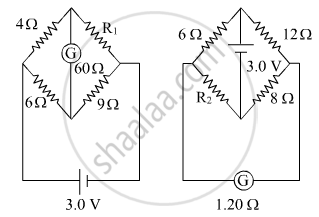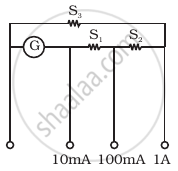Advertisements
Advertisements
प्रश्न
A coil of radius 10 cm and resistance 40 Ω has 1000 turns. It is placed with its plane vertical and its axis parallel to the magnetic meridian. The coil is connected to a galvanometer and is rotated about the vertical diameter through an angle of 180°. Find the charge which flows through the galvanometer if the horizontal component of the earth's magnetic field is BH = 3.0 × 10−5 T.
उत्तर
Given:-
Radius of the coil, r = 10 cm = 0.1 m
Resistance of the coil, R = 40 Ω
Number of turns in the coil, N = 1000
Angle of rotation, θ = 180°
Horizontal component of Earth's magnetic field, BH = 3 × 10−5 T
Magnetic flux, ϕ = NBA cos 180°
⇒ ϕ = −NBA
= −1000 × 3 × 10−5 × π × 1 × 1 × 10−2
= 3π × 10−4 Wb
dϕ = 2NBA = 6π × 10−4 Wb
\[e = \frac{d\phi}{dt} = \frac{6\pi \times {10}^{- 4}}{dt}\]
Thus, the current flowing in the coil and the total charge are:-
\[i = \frac{e}{R} = \frac{6\pi \times {10}^{- 4}}{40dt} = \frac{4 . 71 \times {10}^{- 5}}{dt}\]
\[Q = \frac{4 . 71 \times {10}^{- 5} \times dt}{dt}\]
\[ = 4 . 71 \times {10}^{- 5} C\]
APPEARS IN
संबंधित प्रश्न
The combined resistance of a galvanometer of resistance 500Ω and its shunt is 21Ω. Calculate the value of shunt.
Two moving coil meters, M1 and M2 have the following particulars:
R1 = 10 Ω, N1 = 30,
A1 = 3.6 × 10–3 m2, B1 = 0.25 T
R2 = 14 Ω, N2 = 42,
A2 = 1.8 × 10–3 m2, B2 = 0.50 T
(The spring constants are identical for the two meters).
Determine the ratio of
- current sensitivity and
- voltage sensitivity of M2 and M1.
A rectangular coil of a moving coil galvanometer contains 100 turns, each having area
15 cm2. It is suspended in the radial magnetic field 0.03 T. The twist constant of suspension
fibre is 15 x 10-10 N-m/degree. Calculate the sensitivity of the moving coil galvanometer.
The fraction of the total current passing through the galvanometer is ............ .
a) `S/(S+G)`
b) `G/(S+G)`
c) `(S+G)/G`
d) `(S+G)/S`
A moving coil galvanometer has a resistance of 25Ω and gives a full scale deflection for a current of 10mA. How will you convert it into a voltmeter having range 0 - 100 V?
A galvanometer has a resistance of 16Ω. It shows full scale deflection, when a current of 20 mA is passed through it. The only shunt resistance available is 0.06 which is not appropriate to convert a galvanometer into an ammeter. How much resistance should be connected in series with the coil of galvanometer, so that the range of ammeter is 8 A?
Why is it necessary to introduce a radial magnetic field inside the coil of a galvanometer?
Define the current sensitivity of a galvanometer ?
Figure shows two circuits each having a galvanometer and a battery of 3V.
When the galvanometers in each arrangement do not show any deflection, obtain the ratio R1/R2.

Explain, giving reasons, the basic difference in converting a galvanometer into (i) a voltmeter and (ii) an ammeter?
State the underlying principle of working of a moving coil galvanometer. Write two reasons why a galvanometer can not be used as such to measure current in a given circuit. Name any two factors on which the current sensitivity of a galvanometer depends.
Define the term 'current sensitivity' of a moving coil galvanometer.
A multirange current meter can be constructed by using a galvanometer circuit as shown in figure. We want a current meter that can measure 10 mA, 100 mA and 1A using a galvanometer of resistance 10 Ω and that prduces maximum deflection for current of 1mA. Find S1, S2 and S3 that have to be used

When a galvanometer is shunted with a 4 Ω resistance, the deflection is reduced to one-fifth. If the galvanometer is further shunted with a 2 Ω wire. The further reduction (find the ratio of decrease in current to the previous current) in the deflection will be (the main current remains the same)
A galvanometer shows full-scale deflection for current Ig. A resistance R1 is required to convert it into a voltmeter of range (0 - V) and a resistance R2 to convert it into a voltmeter of range (0 - 2V). Find the resistance of the galvanometer.
A voltmeter has a range of 0 - 20 V and a resistance of 500 Q. Explain how can be used to measure voltages from 0 - 200 volt?
To convert a moving coil galvanometer into an ammeter we need to connect a ______.
